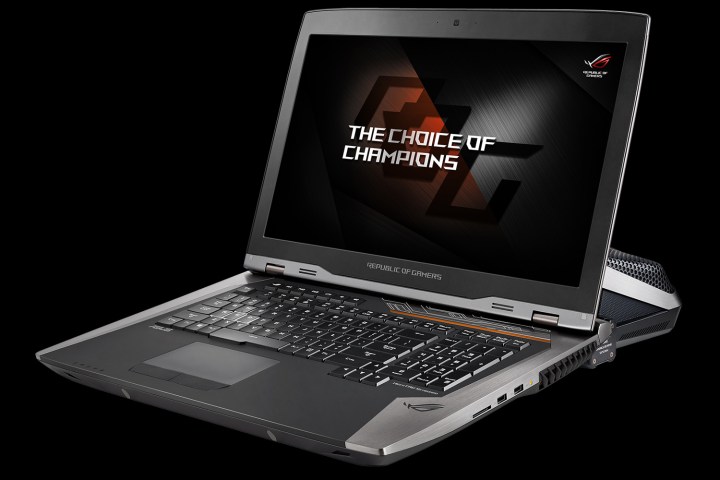
On that note, the Asus ROG notebooks that now support Nvidia’s new Pascal-based discrete GPUs include the GX800, the G800, the G752, and the Strix GL502
Previously released with two GTX 980 GPUs, the base GX800 laptop configuration includes an Intel Core i7-6820HK processor powering an 18.4-inch LED-lit screen supporting Nvidia’s G-Sync technology and a massive 3,840 x 2,160 resolution. It also has the two GTX 1080 GPUs, up to 64GB of DDR4 system memory clocked at 2,800MHz, a 512GB SSD, Wireless AC and Bluetooth 4.1 connectivity, a backlit mechanical keyboard, and an HD webcam. All of this is backed by an 8-cell 76Whrs battery.
As for the G800 model, this laptop has similar specs. The only difference between these two models is that the GX800 version includes the docking port supporting the company’s external water-cooled dock whereas the G800 model does not. That GX800/dock combo essentially enables customers to safely overclock the GPU and CPU past the out-of-the-box overclocked settings while providing an additional power boost to the laptop in the process. However, both laptops can be pushed to higher speeds without the need for the dock; it’s just a safer process with the GX800/dock combo.
“The CPU clocks in at a guaranteed 3.9GHz and can be overclocked to speeds of 4.2GHz and beyond,” the company states. “Meanwhile, the GPU clocks in at 1,734MHz and can be pushed as high as 1,911MHz.”
According to Asus, the G752VS laptop now supports the slower GTX 1070 graphics chip, whereas the G752VM model now supports the even slower GTX 1060 GPU. Both laptops are powered by a sixth-generation Intel Core i7 “Skylake” processor, up to 64GB of DDR4 system memory, and a backlit anti-ghosting keyboard with a 30-key rollover. The company adds that the G752VS includes an overclocking toolkit to push the processor up to 4GHz …. in a laptop, at that.
Finally, the Strix GL502VS now supports the GTX 1070 while the Strix GL502VM now offers the GTX 1060. Both models are “compact and lightweight,” backed by a sixth-generation Intel Core i7 processor. These two super-compact laptops sport 15-inch screens with 178-degree viewing angles, making them great for “heavy” gaming and “productive multitasking” while on the go.
As always, Asus doesn’t provide any pricing in its announcement, so you’ll have to troll Newegg, Amazon, and other Asus notebook dealers for cemented laptop configurations and their pricing.
Editors' Recommendations
- Acer’s new gaming laptop bring Nvidia RTX 40-series GPUs under $1,000
- ROG Zephyrus Duo 16 leak reveals future of AMD, Nvidia gaming laptops
- The Nvidia RTX 3080 is pushing gaming laptops toward a resolution revolution
- Nvidia’s GeForce GTX 1650 Super is set to launch on November 22
- Asus launches a fleet of ROG gaming laptops with 240Hz screens and 9th-gen CPUs


